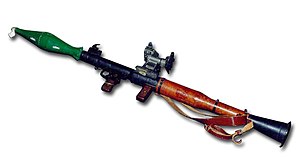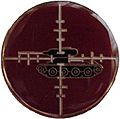44 Parachute Brigade (South Africa)
Upon formation, the brigade was commanded by Brigadier M. J. du Plessis, who was assigned the task of establishing by working with the Parachute Staff Officer, Colonel Jan Breytenbach.
[3] Shortly after formation, it was realised that these two battalions, being infantry units only, were not capable of providing an effective and balanced force for conventional operations.
An all-arms formation with an airborne capability was needed, and as a result, later on the brigade was expanded with various arms including engineering, artillery, signals, anti-aircraft, anti-tank, and maintenance and workshops units.
On 24 September 1980 the Brigade HQ was re-activated with Breytenbach as un-appointed Officer Commanding and moved to the farm Haakdoringfontein at Murrayhill near Wallmansthal, some 35 kilometers north of Pretoria.
This farm once belonged to Commandant General Piet Joubert of the old Zuid-Afrikaansche Republiek, and the original stone farmhouse and outbuildings have been incorporated into the Brigade Headquarters.
A Pathfinding unit, nicknamed the Philistines, was duly established, manned by a combination of ex-Rhodesian soldiers and local volunteers.
In order to achieve this, several National Servicemen Companies from 1 Parachute Battalion were placed under the operational command of the brigade.
The tests originated at 1 Parachute Battalion in 1982 with stripped-down Land-Rovers dubbed 'Fireflies', progressing to successfully dropping light armored reconnaissance vehicles carrying potent anti-tank weapons systems.
In March 1988, Exercise Iron Eagle III was carried out by 2 Parachute Battalion Group on the training grounds at Murrayhill.
The depleted Group prepared for and took part in an Exercise known as Sweepslag II/88 together with other conventional forces at the Army Battle School near Lohatlha in the Northern Cape.
The Paratroopers travelled 500 kilometres by road from Pretoria only to discover that they would immediately have to participate in a night drop with heavy equipment.
The composite force of a battalion minus, Commanded by Col Breytenbach carried out the first-light parachute assault on a SWAPO base code-name "Moscow", at Cassinga in Angola.
This event is remembered in Namibia as the Cassinga massacre, the subject of much continued controversy covered in part during the Truth and reconciliation commission in South Africa.
A permanent Paratrooper Base had been established alongside the Ondangwa Airfield in Owambo, Northern South West Africa, and a company was always on strength and deployed there.
During 1979 companies from 1 Parachute Battalion, as a part of Operation Bowler, achieved remarkably high success rates with Fireforce actions.
1 Parachute Battalion also continued to reinforce mechanised and motorised battle groups during operations into Angola with the support of its paratroopers, often using heliborne tactics.
In 1982 the unit experienced a major setback when a Puma Helicopter was shot down during Operation Meebos by enemy anti-aircraft fire and 12 paratroopers perished.
He had already been Acting Brigade Commander in his previous post as SO1 for several months prior to this performing detached duties with the Joint Military Monitoring Commission on the Angolan / SWA Border.
[9] Shortly after assuming command of the brigade he was tasked with mobilizing 14 Parachute Battalion Group[b] to assist warding off a final infiltration by SWAPO insurgents into northern SWA.
In 1960 fifteen volunteers from the SADF were sent to England, the majority to train as parachute instructors, some as parachute-packers and one SAAF pilot in the dropping of paratroopers.
Members of 1 Parachute Battalion were the first S.A. Army men to see action after World War II when, in 1966, they participated, with the South African Police, against insurgents in S.W.A.
[citation needed] In 1966, members of 1 Parachute Battalion participated in the first action in the war in South West Africa during a heliborne assault on an insurgent base.
McGill Alexander writes that companies from 1,2, and 3 Parachute Battalions operated against Zimbabwean guerrillas inside Rhodesia in September 1979-FEbruary 1980, the last years of the Rhodesian Bush War.
In 1976, 1 Parachute Battalion possessed a limited pathfinder capability in a small group of permanent force members who were Drop Zone Safety Officers and Freefall qualified.
With the lessons learnt from Operation Reindeer in May 1978, it became clear that a method for ensuring correct and safe dropping, grouping and extraction of paratroopers was urgently needed.
In order to have the capability to covertly insert behind enemy lines, and do reconnaissance on the target, the battalion would need to create a formal structure, command system, specialised equipment and operational procedures to support this.
A process was begun to formulate staffing, equipment tables and to establish guidelines for the formation of an extended pathfinder capability within the unit.
A contact was recorded between the Para Sappers and SWAPO during such a long range mission where their retaliatory mortar fire caused the enemy to flee.
In August 2019, 52 Reserve Force units had their names changed to reflect the diverse military history of South Africa.
In August 2019, 52 Reserve Force units had their names changed to reflect the diverse military history of South Africa.












